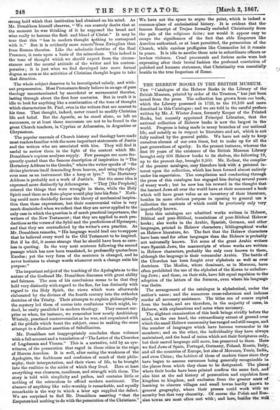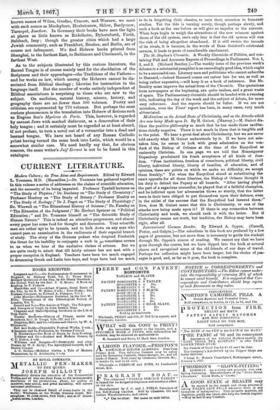THE HEBREW BOOKS IN THE BRITISH MUSEUM. THE " Catalogue of
the Hebrew Books in the Library of the. British Museum, printed by order of the Trustees," has just been issued from the press. The collection has grown from one book, which the Library possessed in 1759, to the 10,100 and more deicribed in this Catalogue ; and we are told in the careful preface, written by Mr. J. Winter Jones, formerly Keeper of the Printed Books, but recently appointed Principal Librarian, that the• national collection of Hebrew books is now the largest in the world. Progress is being made in many branches of our national life, and notably so in respect to literature and art, which is not fully realized by the general public. We have not only to keep ourselves abreast of our own times, but to make up for all the past generations of apathy. In the present instance, whereas the first 90 years of the existence of the British Museum Library brought only 600 Hebrew books to its shelves, the following 19, up to the present day, brought 9,500. Mr. Zedner, the compiler- of the present catalogue, may therefore look with' a paternal in- terest upon the collection, which has been formed almost entirely under his supervision. The compilation and conducting through the press of this catalogue has engaged him during several years. of weary work ; but he now has his reward in the thought that the learned Jews all over the world have at their command a book:' which will have great value as an inventory of their literature, besides its more obvious purpose in opening to general use a collection the contents of which could be previously only very- imperfectly known.
Into this catalogue are admitted works written in Hebrew, Biblical and post-Biblical, translations of post-Biblical Hebrew- books ; also works in the Arabic, Spanish, German, and other- languages, printed in Hebrew characters ; bibliographical works. on Hebrew literature, &c. The fact that the Hebrew characters, have been used for other languages than the Hebrew is probably- not universally known. Yet some of the great Arabic writers. were Spanish Jews, the manuscripts of whose works are written. in Hebrew characters, probably the only ones known to them, although the language is their vernacular Arabic. The battle of. the Churches has been fought over alphabets as well as over doctrines. The Moslim, where dominant, as in Morocco, haver often prohibited the use of the alphabet of the Koran to unbeliev- ing Jews ; and these, on their side, have felt equal repulsion to the adoption of the letters of the Saracen, even where his language was theirs.
The arrangement of the catalogue is alphabetical, under the author's name ; and the numerous cross-references and indexes render all necessary assistance. The titles are of course copied from the books, and are therefore, in the majority of oases, in Hebrew, with explanations and notes when necessary.
The slightest examination of this book brings vividly before the. mind, on the one hand, the extraordinary extent of ground over which the small Hebrew community has ranged and still ranges, and the number of languages which have become vernacular to its members; and on the other, the individuality they have always. maintained, and the bond of union which not their Scriptures only,. but their sacred language still more, has preserved to them. Here we find Jews of Spain, Portugal, Germany, Poland, Russia, Italy, and all the countries of Europe, but also of Morocco, Tunis, India, and even China ; the habitats of those of modern times since they have begun to assume surnames being generally recognizable in the places from which they chose to be designated. The placat , where their books have been printed confirm the same fact, and'
also hint at the sad history of persecution and expulsion from' kingdom to kingdom, and exclusion from the greater seats of
learning to obscure villages and small towns hardly known to general geography, where their presses could work with no security but that very obscurity. Of course the Polish and Rus- sian towns are most often met with ; and here, besides the well
known names of Wilna, Grodno, Cracow, and Warsaw, we meet with such names as Miedzyborz, Hrubrieszow, Sklow, Berdyczew, Tarnopol, Josefow. In Germany their books have seen the light at places as little known as Rodelheim, Dyhernfurth, Sulzbach, Isny ; though the greater cities which had a large Jewish community, such as Frankfort, Breslau, and Berlin, are of course not infrequent. We find Hebrew books printed from Shanghai, in the farthest East, to Baltimore and Cincinnati, in the farthest West.
As to the subjects illustrated by this curious literature, the Sacred Tongue is of course mainly used for the elucidation of the Scriptures and their appendages—the Traditions of the Fathers— and for works on law, which among the Hebrews cannot be dis- sociated from Biblical theology ; likewise for instruction in the language itself. But the number of works entirely independent of Biblical associations is surprising to those who are new to the subject. On medicine, natural history, science, history, and geography there are no fewer than 500 volumes. Poetry and criticism are represented by 770 volumes. But perhaps the most curious phenomenon is the translation into Hebrew of fictions such as Eugene Sue's Mysteres de Paris. This, however, is regarded by earnest Jews with marked disfavour, as a desecration of their holy tongue ; and it certainly must be regarded as at least absurd, if not profane, to turn a novel out of a vernacular into a dead and learned tongue. We have not heard of any Roman Catholic priest having turned the same book into Latin, which would be a somewhat similar case. We need hardly say that, for obvious reasons, the same writer's Alf Errant is not to be found in this catalogue.































 Previous page
Previous page